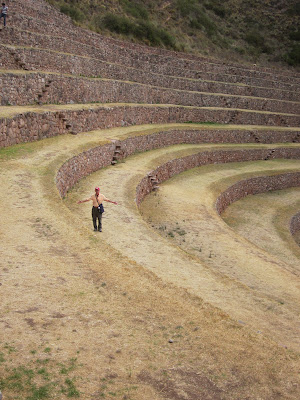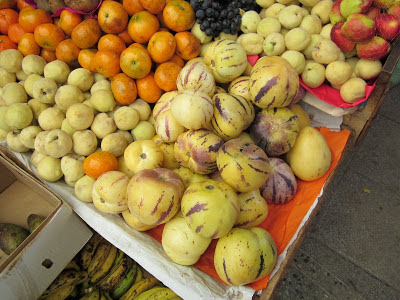 "In one of the most spectacular settings on earth, the great Inca ruler Pachacuti built a royal retreat and scared center known as Machu Pichu. Commenced in the middle of the fiftheen century, it was used by Pachacuti and his roayl family, who continued to improve the site until the empire was destroyed by the Spaniards,... who never visited this site."
"In one of the most spectacular settings on earth, the great Inca ruler Pachacuti built a royal retreat and scared center known as Machu Pichu. Commenced in the middle of the fiftheen century, it was used by Pachacuti and his roayl family, who continued to improve the site until the empire was destroyed by the Spaniards,... who never visited this site."(Ruth Wright, The Machu Pichu Guidebook)
There are two ways to get to Machu Pichu: the original method, by foot, or the modern method, by train. The Inca Trail is not just one trail,
 but a network of ancient roads, getting goods and people from one tambo, or way station, to another. The trails cross each other from Lake Titicaca to Machu Pichu and north, all through the Sacred Valley, and over the mountains to the Colca Canyon and down to the coast. We met other travelers who had chosen to hike the Trail from Cusco to Machu Pichu. We understand it's a beautiful, uphill, four-day hike. Stuart and I took a bus from Urubamba to Ollantaytambo, where we luckily were able to buy train tickets for later that day.
but a network of ancient roads, getting goods and people from one tambo, or way station, to another. The trails cross each other from Lake Titicaca to Machu Pichu and north, all through the Sacred Valley, and over the mountains to the Colca Canyon and down to the coast. We met other travelers who had chosen to hike the Trail from Cusco to Machu Pichu. We understand it's a beautiful, uphill, four-day hike. Stuart and I took a bus from Urubamba to Ollantaytambo, where we luckily were able to buy train tickets for later that day.
pictures: Stuart on the Trail, at the gate to Ollantaytambo; hat vendors at the Ollantaytambo ticket office.



The tickets for non-nationals are much higher priced than the tickets for nationals, and yet it's still far too much money for most Peruvians. Our tickets, round trip, were over $200US. Most Peruvians we met had never seen Machu Pichu, or any of the other wonders of their own country. We had very comfortable seats for the 2 1/2 hour trip from Ollantaytambo to Aquas Calientes
 . We traveled from the high desert, along the river, up to the tropical forest with orchids hanging from tropical zone trees, beyond to the high mountains. The train trip was beautiful! The train tracks to Machu Pichu, beyond Aquas Calientes, were destroyed in an earthquake in 2001 (2000?), a road was built and buses were brought in to ferry tourists the last five miles. Walking from Aquas Calientes is still an option!
. We traveled from the high desert, along the river, up to the tropical forest with orchids hanging from tropical zone trees, beyond to the high mountains. The train trip was beautiful! The train tracks to Machu Pichu, beyond Aquas Calientes, were destroyed in an earthquake in 2001 (2000?), a road was built and buses were brought in to ferry tourists the last five miles. Walking from Aquas Calientes is still an option!In Aquas Calientes, we found a room in the Hostel los Caminantes, the Walkers. Shared bath, cheap. We then found the bus station, to buy tickets to ride the bus the last 5 miles up the mountain tomorrow. We were on the 5:30am bus, light in the sky, but the sun hadn't appeared yet.
The first view of Machu Pichu, driving up the mountain, made us gasp. No chatter on the bus, just awe. Once inside the ticket gate, our first view was from the Guardhouse, overlooking most of the complex.
Stuart and I spent most of the day exploring what would take weeks to see. first hiking to the Bridge to the Sun, then coming back to the terraces above the Temple and houses. We watched the light change as the sun came over the mountain.
The Incans were incredible engineers, building foundations far more complex than modern methods. The beauty of the rock walls is legendary, perfect joinery without tools other than sand, other rocks and bronze. The baths are as complex as the foundations, fresh water running continuously through a series of pools, as thoughtfully designed as any fancy house today.
We were fortunate to have a perfect sky, and several hours before the day-tripping crowds arrived on the 10:30 train to explore. It would take months to see it all, I'm lucky to have had one day in this spectacular place.

 Sunrise, above Machu Pichu.
Sunrise, above Machu Pichu.karen, at the Main Gate, the end or beginning of the Inca Trail to Machu Pichu.







































